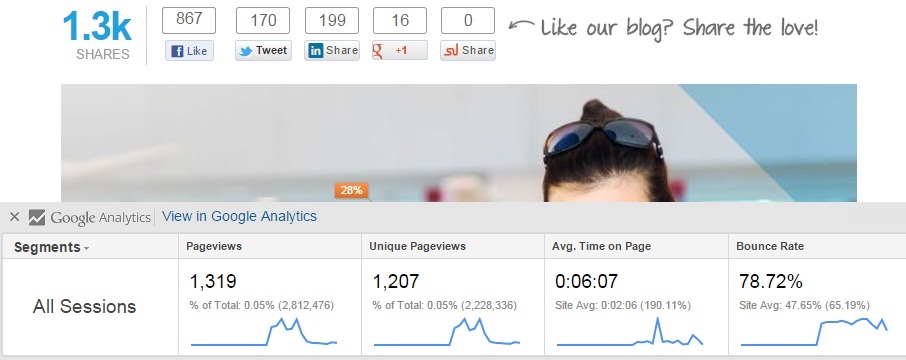4 Building Blocks for SEO Content that Earns Rankings
How do you get your content to earn high rankings? With a keyword density of exactly 4.53% of course!
Alright, come back, I’m just kidding.
Can you believe that just a few years ago the vast majority of the SEO community devoted most of their effort to short-sighted factors like keyword density?
Technical obstacles remain at the foundation of ranking, but they are little more than the foundation:
“Fundamental to a good ranking is the technical performance of a page. The correlation for technological features is often low, or near zero, but … the performance of these factors to ensure good ranking is still mandatory.” – Marcus Tober, Dr. Leonhard Hennig, Daniel Furch, “SEO Ranking Factors and Rank Correlations 2014”
In other words, high-ranking websites tend to have similarly good technical performance, but technical performance alone is not a strong indicator of high rankings. That makes technical factors a barrier to entry, but not an inspiration of competitive advantage.
On the other hand, user engagement is a highly competitive factor to SEO, and key to high rankings. Content that attracts and retains users, and inspires a percentage of them to share/link to said content — that is the stuff that Google will continue to favor.
So how does one create that kind of amazingly juicy content?
Use the Right Visuals and Rich Media
Skip the visual and your audience will skip you. Behold the awesome power of visual content:
- Posts with visuals receive 94% more page visits and engagement than those without.
- 75% of executives watch work-related videos at least once per week.
- Visual content gets 567% more inbound links than text-only content.
It is also true, however, that 94% of a first impression is based on design. So while you need visual content, it needs to be good visual content. That can mean a lot of things, including:
- Shareability – (It’s a word … ) is key. Consider which social network(s) your audience favors, and make sure your visuals conform to the best sizes, shapes, etc. for each. (Look! A social media cheat sheet infographic!)
- Mobile-Friendly – Videos should be as short as possible, and balance audio with text for a variety of viewing environments. Emails should include scalable images. (64% of decision makers read email on mobile devices!)
- Good Images – Don’t steal copyrighted images from a Google Images SERP, and don’t use ugly ones just because they’re free. Here is a list of over 70 sources for free stock images. And somebody on your team has an iPhone too right? No excuses.
Visuals communicate faster and connect more deeply than text-only content. Buyers are only getting busier, so take advantage of images where ever you can.
Make It Easy to Read
It’s easy to turn good ideas into a lot of text. It is very difficult to compress good ideas into rich, consumable snippets that your audience will consume, digest, and share.
How can marketers communicate complex, meaningful concepts in a format that is compelling and engaging, brief and sharable – without losing any of the meaningful meaning? Here are some readability basics:
- Use short paragraphs (4 lines max)
- Write subtitles that quickly guide readers
- Use bold text and callouts
- Lists!
I want my steak tender, juicy and full of flavor: Writing for readability doesn’t mean sacrificing the ‘meat’ of your content. Be sure your content team treats readability as a priority without losing depth or authenticity.
Write for Your Audience and Their Keywords
Keywords mean very little without the context of the people behind them. You may know how many people search for your important keywords every month, but do you know who those people are?
If understanding the buyer is Step 1, and discovering keywords is Step 2, then Step 3 is to understand the user intent(s) of each keyword. The user intent is the specific task a user is trying to accomplish by searching for a specific keyword. They are trying to either Do something, Know (a.k.a. learn) something, or Go somewhere.
One keyword can often represent multiple user intents! Without a knowledge of user intent, attempting to optimize content for a particular keyword is shooting in the dark.
Always write content for real people, using their keywords naturally, with an understanding of the ‘user intent’ behind each keyword.
Analyze and Respond to User Engagement
Do you know the bounce rate of each blog post you write? What about share count vs. actual visits, and time on site? (Your post may get re-tweeted, but that doesn’t mean users actually visited your site, or read the material, or spent time on the rest of your site.)
Knowing is half the battle, and Google Analytics makes an enormous amount of data available. Blog managers often find the Analytics interface to be a bit overwhelming, but the relatively new Page Analytics Chrome plugin takes that data and makes it even easier to access.

Know what content underperformed and ask yourself why. Look at the content that is performing very well, consider why, and do more of it!
(I’m amazed time and again to work with clients whose blog has never provided any true value to the business, yet they continue to push out the same boring content, never looking at their data and asking basic questions.)
If You Build It (Well) They Will Come
The competition for high rankings is only increasing as more and more businesses invest in quality content. Users have more than enough choices when it comes to finding the information they are looking for. If you want Google to take notice of your site, your content must stand out!
What's Next?
Profound Strategy is on a mission to help growth-minded marketers turn SEO back into a source of predictable, reliable, scalable business results.
Start winning in organic search and turn SEO into your most efficient marketing channel. Subscribe to updates and join the 6,000+ marketing executives and founders that are changing the way they do SEO:
And dig deeper with some of our best content, such as The CMO’s Guide to Modern SEO, Technical SEO: A Decision Maker’s Guide, and A Modern Framework for SEO Work that Matters.




